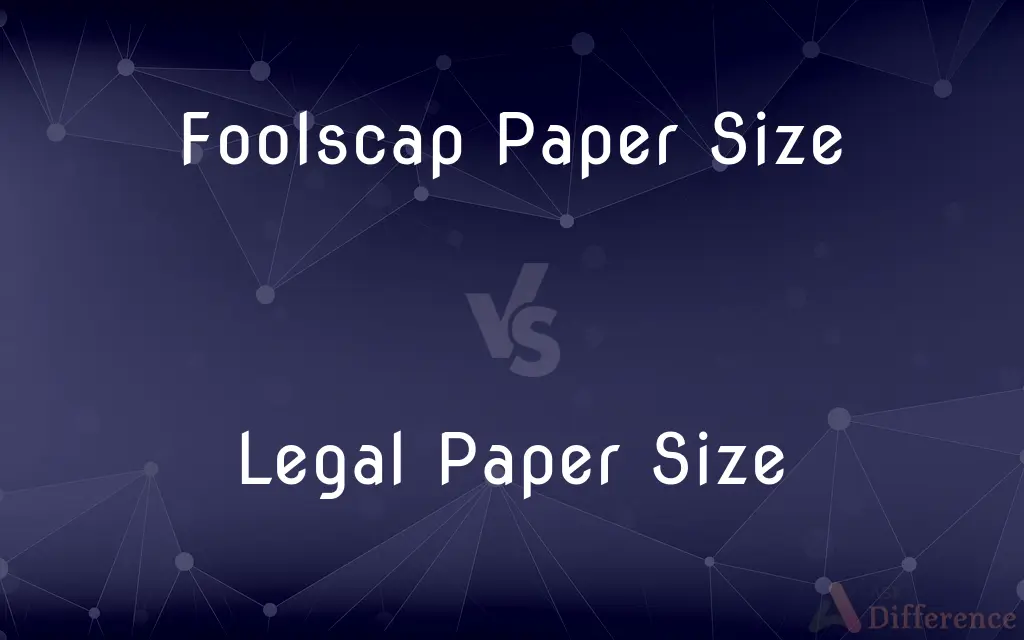Foolscap Paper Size vs. Legal Paper Size — What's the Difference?
By Tayyaba Rehman & Urooj Arif — Published on February 7, 2024
Foolscap is a traditional paper size (8.5" x 13.5") used historically, while Legal is 8.5" x 14", commonly used in law and business.

Difference Between Foolscap Paper Size and Legal Paper Size
Table of Contents
ADVERTISEMENT
Key Differences
Foolscap paper size, traditionally 8.5" x 13.5", was widely used in the British Commonwealth before the adoption of the A4 standard. Legal paper size, measuring 8.5" x 14", is predominantly used in the United States for legal documents and contracts, offering slightly more length for detailed text.
The origin of the term "Foolscap" comes from the watermark of a fool’s cap and bells historically used on this size of paper. Legal size paper, on the other hand, has no such historical watermark but is defined by its specific use in legal documents, providing extra space for legal jargon and clauses.
Foolscap paper size has seen a decline in usage with the global shift towards standardized paper sizes such as A4. However, Legal paper size remains in active use within the legal, business, and government sectors in the U.S., where the extra inch in length accommodates more content per page.
In terms of practicality, Foolscap was once preferred for handwritten notes, manuscripts, and official records in the pre-digital era. Legal size paper, with its additional length, is suited for documents that require extensive legal disclosures, agreements, and forms that benefit from the extra space.
Despite the decline in the use of Foolscap paper size, it remains a part of historical and literary discussions. Legal paper size, with its continued relevance in the professional world, underscores the adaptability and evolving nature of paper standards in response to specific industry needs.
ADVERTISEMENT
Comparison Chart
Dimensions
Approximately 8.5" x 13.5"
8.5" x 14"
Origin
British Commonwealth, historical use
United States, legal and business
Current Usage
Declined, historical interest
Widely used in legal documents
Watermark
Traditionally had a fool’s cap
No specific watermark
Practical Use
Manuscripts, notes (historically)
Legal documents, detailed contracts
Compare with Definitions
Foolscap Paper Size
A historical paper size larger than A4, used before standardization.
The archive contained documents on foolscap paper size, revealing their age.
Legal Paper Size
A preferred paper size in the U.S. for legal documents, measuring 8.5" x 14".
The contract was printed on legal paper size to accommodate its length.
Foolscap Paper Size
Characterized by its traditional watermark of a fool’s cap.
The foolscap paper size was easily identifiable by its unique watermark.
Legal Paper Size
Its length allows for more content per page, reducing the number of pages in lengthy documents.
The legal document was more manageable thanks to the legal paper size.
Foolscap Paper Size
Slightly larger than the modern A4, offering more writing space.
The novelist preferred foolscap paper size for its extra margin space.
Legal Paper Size
Despite its specific association with legal work, it's also used for various professional documents.
The report was printed on legal paper size to include extensive footnotes.
Foolscap Paper Size
Once a common standard in the British Commonwealth for official documents.
Governments used foolscap paper size for their official correspondence.
Legal Paper Size
Widely used in legal, business, and government settings for formal documents.
The attorney requested all filings on legal paper size for clarity.
Foolscap Paper Size
Now mostly obsolete, but remains a term in literary and historical discussions.
The manuscript was originally drafted on foolscap paper size, adding to its historical value.
Legal Paper Size
Offers an additional inch compared to standard letter size, useful for detailed text.
Legal paper size was chosen for the proposal to avoid crowding the text.
Common Curiosities
What is Foolscap paper size?
Foolscap is a historical paper size, approximately 8.5" x 13.5", used primarily before the adoption of the A4 standard.
Are Foolscap and Legal paper sizes still used today?
Foolscap has largely fallen out of use, replaced by A4, while Legal size is still widely used in the U.S. for legal and professional documents.
Is Legal paper size accepted internationally?
Legal size is primarily used in the United States and may not be accepted as a standard size for official documents in other countries.
Why has Foolscap paper size fallen out of use?
The global shift towards standardized sizes like A4 for compatibility and efficiency in printing and filing systems has led to the decline of Foolscap.
Can I use Foolscap paper size for official documents now?
While uncommon, Foolscap can still be used for personal or internal documents but might not be accepted for official submissions where A4 is the standard.
What was the reason behind the specific dimensions of Foolscap paper?
The dimensions of Foolscap paper were based on historical manufacturing processes and the presence of a watermark depicting a fool's cap.
What are the advantages of using Legal paper size?
Legal paper size offers extra length, making it suitable for documents that require detailed clauses and extensive information without increasing the page count.
How does the use of Foolscap paper size affect document archiving?
Documents in Foolscap size may require special consideration in archiving due to their non-standard dimensions compared to current standards.
Why is it called "Legal" paper size?
The "Legal" name comes from its frequent use in legal documents, which often require more length for detailed texts.
What are some tips for printing on Legal paper size to ensure proper formatting?
Ensure the document's page size is set to Legal within the software, use a printer that supports Legal size, and check the print preview to avoid cut-off text or margins.
Can I print on Legal paper size with any printer?
Most modern printers can accommodate Legal paper size, but it's advisable to check the printer's specifications for compatibility.
How should I convert documents from Foolscap to A4 or Legal to Letter size?
Converting documents may require adjusting margins, font sizes, and layout to maintain readability and formatting on the new size.
Are there any legal requirements to use Legal paper size in the U.S.?
While not a legal requirement, Legal size is often preferred for legal documents due to tradition and the practicality of its dimensions.
Can documents on Legal paper size be legally binding outside the U.S.?
The legal binding of a document is determined by its content, not the paper size, though local standards may affect its presentation.
Is there a digital equivalent for Foolscap and Legal paper sizes in document software?
Many word processing and document software programs offer templates for various paper sizes, including Legal; Foolscap might be less commonly available but can be manually set.
Share Your Discovery

Previous Comparison
Friend Function vs. Friend Class
Next Comparison
Optical Fiber Cable vs. Coaxial CableAuthor Spotlight
Written by
Tayyaba RehmanTayyaba Rehman is a distinguished writer, currently serving as a primary contributor to askdifference.com. As a researcher in semantics and etymology, Tayyaba's passion for the complexity of languages and their distinctions has found a perfect home on the platform. Tayyaba delves into the intricacies of language, distinguishing between commonly confused words and phrases, thereby providing clarity for readers worldwide.
Co-written by
Urooj ArifUrooj is a skilled content writer at Ask Difference, known for her exceptional ability to simplify complex topics into engaging and informative content. With a passion for research and a flair for clear, concise writing, she consistently delivers articles that resonate with our diverse audience.
















































